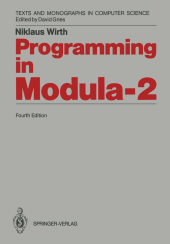 Neuerscheinungen 2011Stand: 2020-01-07 |
Schnellsuche
ISBN/Stichwort/Autor
|
Herderstraße 10
10625 Berlin
Tel.: 030 315 714 16
Fax 030 315 714 14
info@buchspektrum.de |

Niklaus Wirth
Programming in Modula-2
4. Aufl. 2011. ii, 182 S. II, 182 pp. 244 mm
Verlag/Jahr: SPRINGER, BERLIN 2011
ISBN: 3-642-83567-8 (3642835678)
Neue ISBN: 978-3-642-83567-4 (9783642835674)
Preis und Lieferzeit: Bitte klicken
This text is an introduction to programming in general, and a manual for programming with the language Modula-2 in particular. It is oriented primarily towards people who have already acquired some basic knowledge of programming and would like to deepen their understanding in a more structured way. Neveltheless, an introductory chapter is included for the benefit of the beginner, displaying in a concise form some of the fundamental concepts of computers and their programming. The text is therefore also suitable as a self-contained tutorial. The notation used is Modula-2, which lends itself well for a structured approach and leads the student to a working style that has generally become known under the title of structured programming. As a manual for programming in Modula-2, the text covers practically all facilities of that language. Part 1 covers the basic notions of the variable, expression, assignment, conditional and repetitive statement, and array data structure. Together with Palt 2 which introduces the important concept of the procedure or subroutine, it contains essentially the material commonly discussed in introductory programming courses. Part 3 concerns data types and structures and constitutes the essence of an advanced course on programming. Palt 4 introduces the notion of the module, a concept that is fundamental to the design of larger programmed systems and to programming as team work. The most commonly used utility programs for input and output are presented as examples of modules.
1 Introduction.- 2 A First Example.- 3 A Notation to Describe the Syntax of Modula.- 4 Representation of Modula Programs.- 5 Statements and Expressions.- 6 Control Structures.- 7 Elementary Data Types.- 8 Constant and Variable Declarations.- 9 The Data Structure Array.- 10 Procedures.- 11 The Concept of Locality.- 12 Parameters.- 13 Function Procedures.- 14 Recursion.- 15 Type Declarations.- 16 Enumeration Types.- 17 Subrange Types.- 18 Set Types.- 19 Record Types.- 20 Records with Variant Parts.- 21 Dynamic Structures and Pointers.- 22 Procedure Types.- 23 Modules.- 24 Definition and Implementation Parts.- 25 Program Decomposition into Modules.- 26 Local Modules.- 27 Sequential Input and Output.- 28 Screen-Oriented Input and Output.- 29 Low-Level Facilities.- 30 Concurrent Processes and Coroutines.- 31 Device Handling, Concurrency, and Interrupts.- Report on the Programming Language Modula-2.- Appendix 1: The Syntax of Modula-2.- Appendix 2: Standard Utility Modules.- Appendix 3: The ASCII Character Set.- Appendix 4: Syntax Diagrams.


